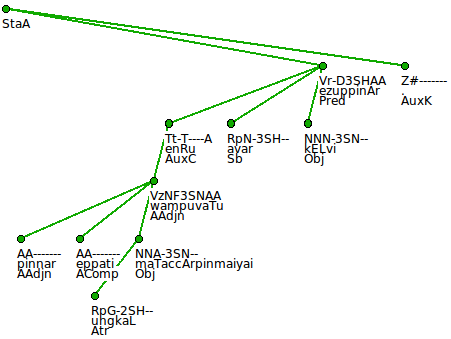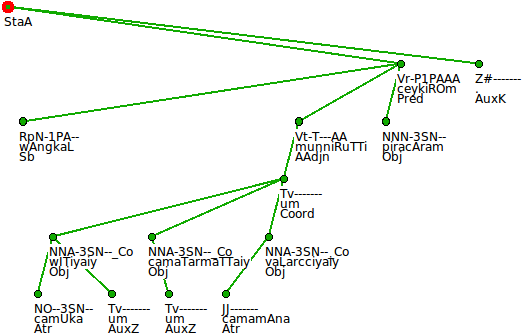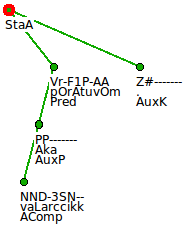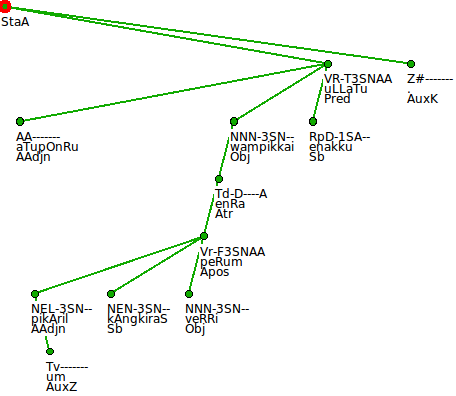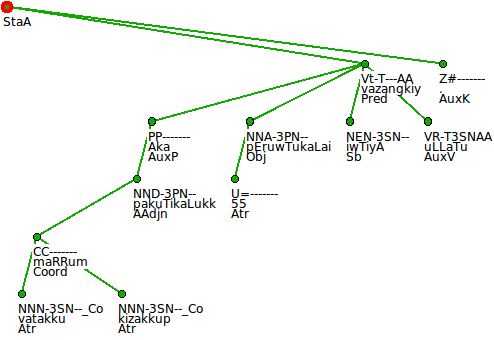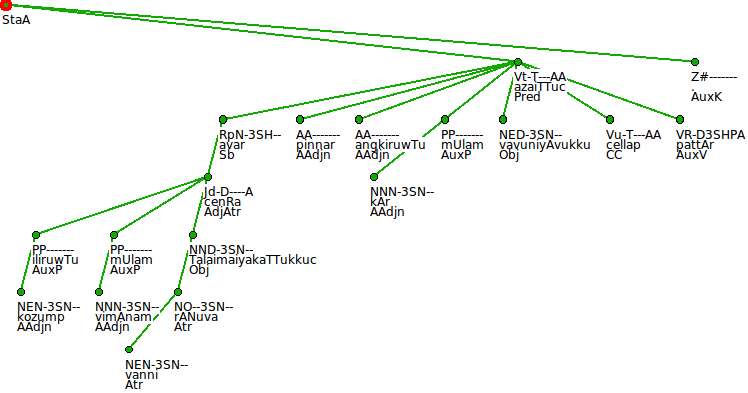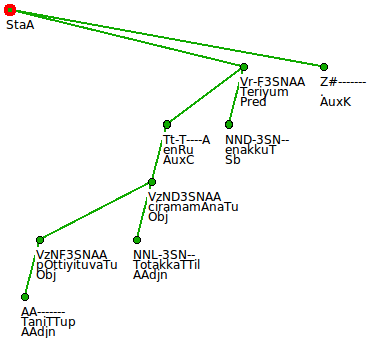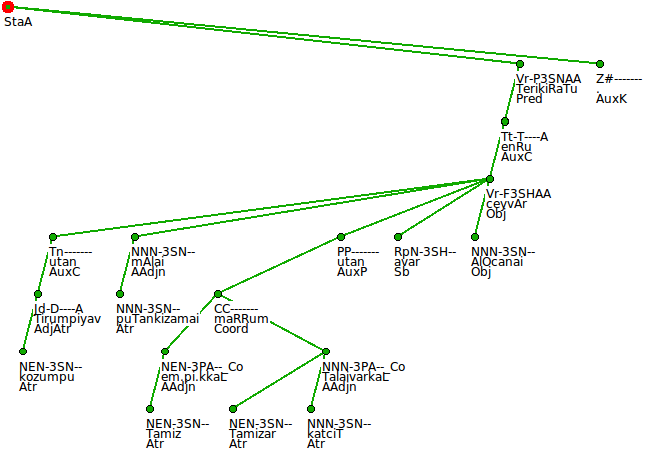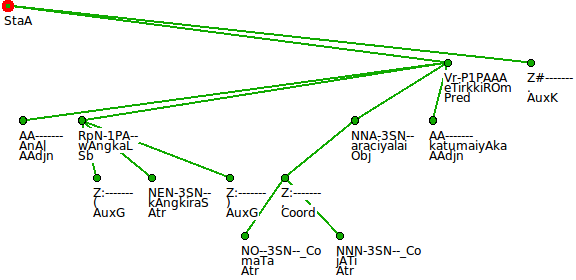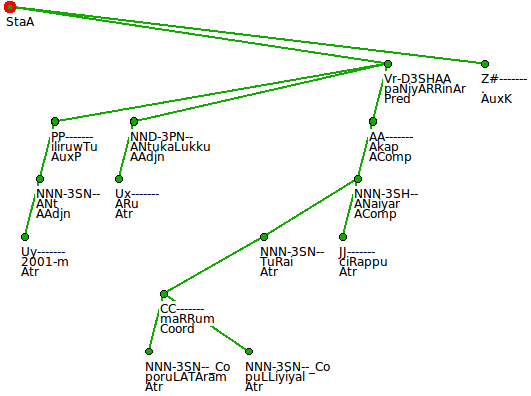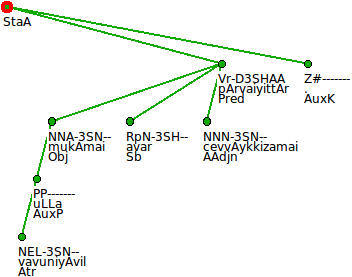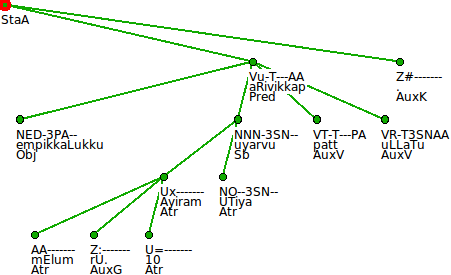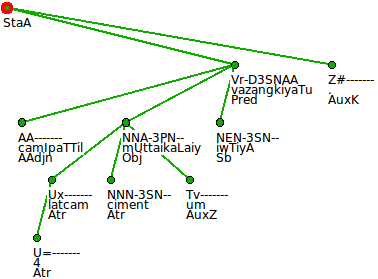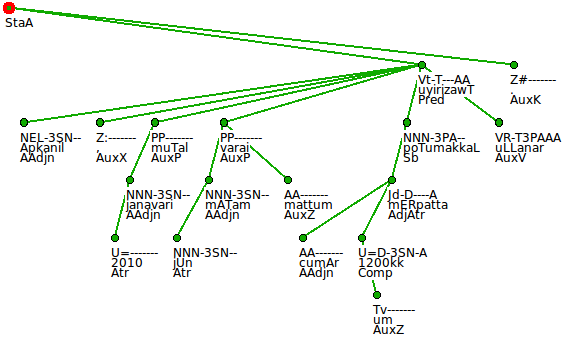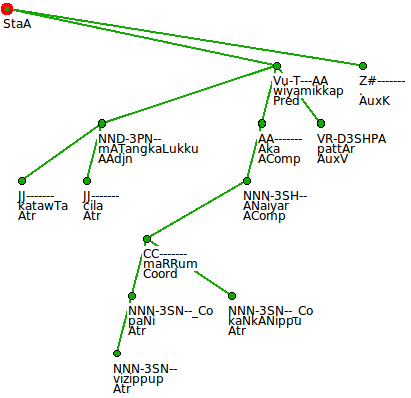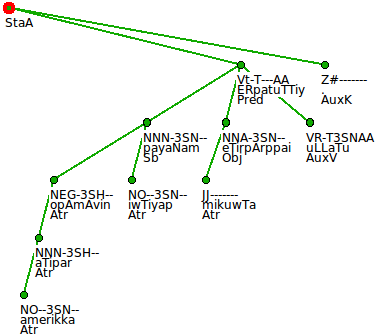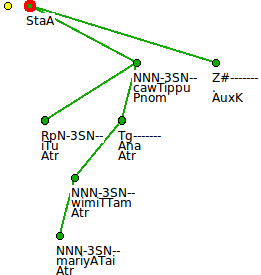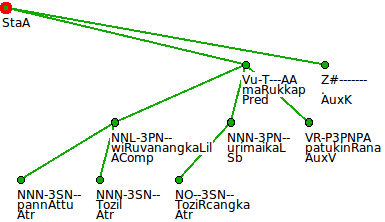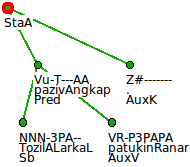Syntactic Annotation
This section will give a
detatiled description about how annotation takes place at the syntactic
level. The syntactic annotation consists of two phases: (i)
identifying the structure (dependency) of the sentence in the form of
tree and (ii) identifying the dependency relations and assigning those
relations to the edges in the tree structure.
The structure of the sentence is identified manually by attaching the
dependent nodes to the governing nodes. In the sentential structure,
the head of the sentence will be predicate, and the predicate will have
arguments (noun phrases, adverbials) as their children. The objective
of this step would be, identifying the predicate rooted structure and
attaching to the techincal root (AuxS, defined below) of the tree. The
end of the sentence will also be attached to the technical root.
Once the structure is identified, all the edges have to be labeled with
their relations. For technical reasons, the relation between the
dependent and the governing node is stored as an a-layer attribute of the
dependent node. The attribute is called
'afun'. The following sections
explains each relation in detail.
Table 4.1: Dependency Relations (Afun values)
No
|
Afun
|
Description
|
1
|
AAdjn
|
Adverbial Adjunct
|
2
|
AComp
|
Adverbial Complement
|
3
|
Apos
|
Apposition
|
4
|
Atr
|
Attribute
|
5
|
AdjAtr |
Adjectival participial or
Adjectivalized verbs
|
6
|
AuxA
|
Determiners
|
7
|
AuxC
|
Subordinating conjunctions
|
8
|
AuxG
|
Symbols other than comma
|
9
|
AuxK
|
Sentence termination symbols
|
10
|
AuxP
|
Postpositions
|
11
|
AuxS
|
Technical root
|
12
|
AuxV
|
Auxiliary verb
|
13
|
AuxX
|
Comma other than in coordination
|
14
|
AuxZ
|
Emphasis words or particles
|
15
|
CC
|
Part of a word
|
16
|
Comp
|
Complement other than attaching
to verbs
|
17
|
Coord
|
Coordination node
|
18
|
Obj
|
Object (both direct and indirect)
|
19
|
Pnom
|
Predicate nominal
|
20
|
Pred
|
Predicate
|
21
|
Sb
|
Subject
|
The usage of analytical function or 'afun'
or dependency relation in the following sections, they all refer to the
dependency relation between dependent node and the governing node.
In this sub section, each analytical function defined in the
Table 4.1 is explained in
detail.
AAdjn
The
AAdjn relation is used to mark the adverbial adjuncts. The adverbial
adjuncts are optional adverbial phrases, postpositional phrase, clauses or simple adverbs modifying the verbs.
Tamil:
|
பின்னர்
|
எப்படி
|
உங்கள்
|
மதச்சார்பின்மையை
|
நம்புவது
|
என்று
| கேள்வி
|
எழுப்பினார்
|
.
|
Tr:
|
pinnar
|
eppati
|
ungkaL
|
maTaccArpinmaiyai
|
wampuvaTu
|
enRu
| kELvi
|
ezuppinAr
|
.
|
Gloss:
|
then
|
how
|
your
|
secular credential-ACC
|
believing
|
that
| question
|
raised-he
|
.
|
English:
|
" Then how to believe your secular credentials ", he raised a question
|
The
Figure 4.1 shows how
simple adverb (pinnar/'then, later') has been labeled with
AAdjn label. The following
Figure 4.2 shows how an adverbial phrase ("by putting forward ...") has been labeled with
AAdjn label.
Tamil:
|
நாங்கள்
|
சமூக
|
நீதியை
|
உம்
|
சமதர்மத்தை
|
உம்
| சமமான
|
வளர்ச்சியை
|
உம்
| முன்னிறுத்தி
|
பிரசாரம்
|
செய்கிறோம்
|
.
|
Tr:
|
wAngkaL
|
camUka
|
wITiyai
|
um
|
camaTarmaTTai
|
um
| camamAna
|
vaLarcciyai
|
um
| munniRuTTi
|
piracAram
|
ceykiROm
|
.
|
Gloss:
|
we
|
social
|
justice
|
-
|
equality
|
-
| equal
|
development
|
-
| by putting forward
|
campaign
|
do
|
.
|
English:
|
We are doing campaign by putting forward social justice, equality and equal development .
|
AComp
The
AComp relation is used to mark the obligatory adverbials or adverbial complements in the structure. The context of occurrence of
AComp relation is same as that of
AAdjn relation. The only difference is that the '
adverbial adjuncts' (AAdjn) are optional elements in the sentential structure whereas
'adverbial complements (AComp)'are
obligatory elements in the sentence structure. While doing
annotation, this relationship is determined by whether the
'adverbial
structure' is required to complete the sentence. If the removal of the
adverbial structure does not affect the sentence as a whole, then it is
labeled
as
AAdjn or it will be labeled as
AComp. The following
Figure 4.3 illustrate this idea.
Tamil:
|
வளர்ச்சிக்க்
|
ஆக
|
போராடுவோம்
|
.
|
Tr:
|
vaLarccikk
|
Aka
|
pOrAtuvOm
|
.
|
Gloss:
|
development
|
for (the sake of)
|
struggle-we
|
.
|
English:
|
We will struggle for development .
|
In
Figure 4.3,
the
phrase "
vaLarccikkk Aka (for development)" occurs as an obligatory
element in the sentence. Though it can be argued that in Tamil it is
possible to write a minimal sentence with just a verb, the decision is
made mainly based on whether the sentence conveys the meaning without
loosing the essential information.
Apos
The adjectival clauses headed by
enRa are appositional clauses. The entire finite clause will be attached to
enRa which will act as a modifier to a noun phrase. The clausal head which is attached to
enRa will receive
Apos label. The following
Figure 4.4 illustrates the labeling of
Apos.
Tamil:
|
அதுபோன்று
|
பிகாரில்
|
உம்
|
காங்கிரஸ்
| வெற்றி
|
பெறும்
|
என்ற
|
நம்பிக்கை
|
எனக்கு
| உள்ளது
|
.
|
Tr:
|
aTupOnRu
|
pikAril
|
um
|
kAngkiraS
| veRRi
|
peRum
|
enRa
|
wampikkai
|
enakku
| uLLaTu
|
.
|
Gloss:
|
like that
|
in Bihar
|
also
|
Congress
| victory
|
gain
|
that
|
confidence
|
me
| be-exist
|
.
|
English:
|
I have a confidence that similarly in Bihar too the Congress will gain victory .
|
Other occurrence of appositions are not handled at present. It will be included in future versions of the annotation.
Atr
Attribute (refer
PDT
documentation) is a sentence member which depends on noun and
closely determines its meaning. Original PDT annotation diferentiates
"agreeing" and
"non-agreeing"
attribute. But, since Tamil does not have any agreement between nouns
and their modifers, all noun modifers will receive the afun label Atr.
The noun modifiers include nouns (except the head noun) in noun
compounds, adjectives, numerals and adjectival participles. The
Figure 4.5
shows the usage of afun Atr.
Tamil:
|
வடக்கு
|
மற்றும்
|
கிழக்குப்
|
பகுதிகளுக்க்
| ஆக
|
55
|
பேருந்துகளை
|
இந்தியா
|
வழங்கிய்
|
உள்ளது
|
.
|
Tr:
|
vatakku
|
maRRum
|
kizakkup
|
pakuTikaLukk
| Aka
|
55
|
pEruwTukaLai
|
iwTiyA
|
vazangkiy
|
uLLaTu
|
.
|
Gloss:
|
north
|
and
|
east
|
regions
| for
|
55
|
buses
|
India
|
give
|
AUX-PERF
|
.
|
English:
|
India has provided 55 buses to north and eastern regions . |
AdjAtr
AdjAtr label is
used to mark the adjectival clauses, adjectivalized verbs or adjectival participials. They
are equivalent to -ing, -ed (
singing girl,
departed
train) forms in English. Verbs in Tamil can be adjectivalized for all
three tenses, and they take appropriate tags depending on the word form
features. The Figure shows an example for
AdjAtr labeling.
Tamil:
|
கொழும்ப்
|
இலிருந்து
|
விமானம்
|
மூலம்
| வன்னி
|
ராணுவ
|
தலைமயகத்துக்குச்
|
சென்ற
|
அவர்
|
பின்னர்
|
அங்கிருந்து |
கார்
|
மூலம்
|
வவுனியாவுக்கு
|
அழைத்துச்
|
செல்லப்
|
பட்ட்டார்
|
.
|
Tr:
|
kozump
|
iliruwTu
|
vimAnamp
|
mUlam
| vanni
|
rANuva
|
TalaimaiyakaTTukkuc
|
cenRa
|
avar
|
pinnar
|
angkiruwTu
|
kAr
|
mUlam
|
vavuniyAvukkv
|
azaiTTuc
|
cellap
|
pattAr
|
.
|
Gloss:
|
Colombo
|
from
|
plane
|
through
| vanni
|
military
|
headquarters-to
|
who went
|
he or she
|
later
|
from there
|
car
|
through
|
to VavuniyA
|
taken
|
|
|
|
English:
|
He/she who went to Vanni Military Headquarters by plane from Colombo, was later taken to VavuniyA from there by car.
|
AuxA
Tamil has two demonstrative determiners corresponding to 'this' and 'that'
in English. At present, the question word
ewTa/'which' is also tagged as
determiner. Sometimes the determiners occur as a prefix to the
following noun or noun phrase in a contracted form. During the
tokenization phase, these demonstrative suffixes will be separated from
the noun or noun phrase, and will be considered as a separate token.
The determiners are
iwTa/'this', awTa /'that' and ewTa/'which', and the corresponding
contracted determiners are i, a and e. Due to orthorgraphic rules, the
first letter of the following noun phrase will be added to the
contracted form. The
Figure 4.7 illustrates the usage of all
determiners.
Tamil:
|
அப்
|
பகுதியில்
|
வாழ்ந்தவர்கள்
|
தான் ...
|
Tr:
|
ap
|
pakuTiyil
|
vAzwTavarkaL
|
TAn ...
|
Gloss:
|
that
|
in the region
|
those who have lived
|
EMPHASIS
|
English:
|
It was those who have lived in that region
|
Tamil:
|
இச்
|
சட்டத்தின்
|
படி
|
Tr:
|
ic
|
cattaTTin
|
pati
|
Gloss:
|
this
|
law
|
according to
|
English:
|
according to this law |
Tamil:
|
இந்தப்
|
புதிய
|
சட்டம்
|
Tr:
|
iwTap
|
puTiya
|
cattam
|
Gloss:
|
this
|
new
|
law
|
English:
|
this new law |
Tamil:
|
அந்த
|
நிதி
|
உதவியை
|
Tr:
|
awTa
|
wiTi
|
uTaviyai
|
Gloss:
|
that
|
financial
|
help
|
English:
|
that financial help |
AuxC
In Tamil, embedding or adjoining of clauses are performed either by
morphologically marking the clause or by using separate words. When
separate words are used, they function similar to that of subordinating
conjunction words in other languages such as English. These separate
words are called complementizers in Tamil. Complementizers can be
verbs, nouns or postpositions after nominalized clauses. There are
three complementizing verbs -
en/'say',
pOl/'seem' and
Aku/'become'.
They have grammatical function during embedding of clauses, otherwise
they retain their lexical meaings. The following list provides some of
the noun complementizers -
pOTu/'time', mun/'before', piRaku/'after', utan/'immediacy', varai/'as long as' and etc. The
postpositions can also be interpreted as subordinating conjunction
words when they were preceded by nominalized clauses.
Refer [1] for
detailed treatment of how complementizers work in Tamil.
Tamil:
|
தனித்துப்
|
போட்டியிடுவது
|
தொடக்கத்தில்
|
சிரமமானது
| என்று
|
எனக்குத்
|
தெரியும்
|
.
|
Tr:
|
TaniTTup
|
pOttiyituvaTu
|
TotakkaTTil
|
ciramamAnaTu
| enRu
|
enakkuT
|
Teriyum
|
.
|
Gloss:
|
separately
|
competing
|
in the beginning
|
difficult
| that
|
I
|
know
|
.
|
English:
|
I know that it will be difficult in the beginning to compete separately .
|
Tamil:
|
கொழும்பு
|
திரும்பியவ்
|
உடன்
|
புதன்கிழமை
|
மாலை
|
தமிழ்
|
எம்பிக்க்க்ள்
|
மற்றும்
|
தமிழர்
|
கட்சித்
|
தலைவர்கள்
|
உடன்
|
அவர்
|
ஆலோசனை
|
செய்வார்
|
என்று
|
தெரிகிறது
|
.
|
Tr:
|
kozumpu
|
Tirumpiyav
|
utan
|
puTankizamai
|
mAlai
|
Tamiz
|
empikkaL
|
maRRum
|
Tamizar
|
katciT
|
TalaivarkaL
|
utan
|
avar
|
AlOcanai
|
ceyvAr
|
enRu
|
TerikiRaTu
|
.
|
Gloss:
|
Colombo
|
return
|
as soon as
|
Wednesday
|
evening
|
Tamil
|
MPs
|
and
|
Tamil
|
party
|
leaders
|
|
he/she
|
discussion
|
do
|
that
|
seem
|
.
|
| English:
|
It seems
that she will discuss with Tamil MPs and Tamil party leaders as soon as she returns to Colombo .
|
The
Figures 4.8 and
Figure 4.9 illustrate the usage of
AuxC.
AuxG
The symbols other than
comma and
sentence boundaries are labeled with AuxG. The
Figure 4.10 shows the usage of AuxG label.
Tamil:
|
ஆனால்
|
நாங்கள்
|
(
|
காங்கிரஸ்
| )
|
மத
| ,
|
ஜாதி
|
அரசியலை
|
கடுமையாக
|
எதிர்க்கிறோம்
|
.
|
Tr:
|
AnAl
|
wAngkaL
|
(
|
kAngkiraS
|
)
|
maTa
| ,
|
jATi
|
araciyalai
|
katumaiyAka
|
eTirkkiROm
|
.
|
Gloss:
|
But
|
we
|
(
|
Congress
|
)
|
religious
|
|
caste |
politics |
vehemently
|
oppose-we
|
|
English:
|
But we (Congress) vehemently oppose the religious and caste poltics .
|
AuxK
AuxK is the
sentence terminal punctuation, usually full stop at the end of a
sentence will receive this label. There are also other symbols such as
(:, ?, !), will also receive
AuxK.
AuxP
AuxP is used to mark the
postpositions (heads) of the postpositional phrases. The
postposition will recieve the
AuxP label and the element attached to
AuxP will receive the afun (AAdjn , AComp, Atr, Comp) according to
their context of occurrence. The following figures show, how
AuxP is labeled.
Tamil:
|
2001-ம்
|
ஆண்ட்
|
இலிருந்து
|
ஆறு
|
ஆண்டுகளுக்கு
|
பொருளாதாரம்
| மற்றும்
|
புள்ளியியல்
|
துறை
|
சிறப்பு
|
ஆணையர்
|
ஆகப்
|
பணியாற்ல்றினார்
|
.
|
Tr:
|
2001-m
|
ANt
|
iliruwTu
|
ARu
|
ANtukaLukku
|
poruLATAram
| maRRum
|
puLLiyiyal
|
TuRai
|
ciRappu
|
ANaiyar
|
Akap
|
paNiyARRinAr
|
.
|
Gloss:
|
in 2001
|
year
|
from
|
six
|
years
|
economy
| and
|
statistics
|
department
|
special
|
commissioner
|
-
|
worked-he
|
.
|
English:
|
from 2001, (he) worked as special comminssioner of economy and statistics depeartment for six years.
|
Tamil:
|
வவுனியாவில்
|
உள்ள
| முகாமை |
அவர்
|
செவ்வாய்க்கிழமை
|
பார்வையிட்டார்
| .
|
Tr:
|
vavuniyAvil
|
uLLa
|
mukAmai
|
avar
|
cevvAykkizamai
|
pArvaiyittAr
| .
|
Gloss:
|
in vavunia
|
exist
|
camp
|
he/she
|
on Tuesday
|
visited
| .
|
English:
|
On Tuesday, he/she visited the camp in the vavuniya .
|
AuxS
AuxS is used to label the technical root of a tree. In the
Figure 4.12,
the technical root (StaA) is the root of the tree structure . To this
node, the predicate and the sentencing ending node will be attached .
AuxV
Auxiliary verbs are assigned the afun AuxV. In compound
verb constructions, the auxiliary verb will be hanged under
lexical verb. All auxiliary words including passive constructions will receive tha afun AuxV
In the
Figure 4.13,
there are two auxiliary verbs (
patu/'experience,' uL/'exist'). The auxiliary
patu/'experience' and
uLLaTu/'be exist' are labeled with
AuxV. The lexical verb will receive the label
Pred if there is only one clause in the sentence, otherwise the label of the lexical verb will depend upon the upper clauses.
Tamil:
|
எம்பிக்களுக்கு
|
மேலும்
|
ரூ.
|
10
|
ஆயிரம்
|
ஊதிய
| உயர்வு
|
அறிவிக்கப்
|
பட்ட்
|
உள்ளது
|
. |
Tr:
|
empikkaLukku
|
mElum
|
rU.
|
10
|
Ayiram
|
UTiya
| uyarvu
|
aRivikkap
|
patt
|
uLLaTu
|
.
|
Gloss:
|
to MPs
|
more
|
Rs.
|
10
|
thousand
|
salary
| increment
|
announced
|
AUX-PASS
|
AUX-PERF
|
.
|
English:
|
Rs. 10000 more salary increment has been announced.
|
AuxX
All commas except the commas acting as coordinators will receive the afun
AuxX.
AuxZ
The clitics
um, E, TAn, mattum will receive the afun
AuxZ. The Figure 4.14 illustrates the labeling
AuxZ.
Tamil:
|
சமீபத்தில்
|
4
|
லட்சம்
|
சிமெண்ட்
|
மூட்டைகளைய்
|
உம்
|
இந்தியா
| வழங்கியது
|
.
|
Tr:
|
camIpaTTil
|
4
|
latcam
|
cimeNt
|
mUttaikaLy
|
um
|
iwTiyA
| vazangkiyaTu
|
.
|
Gloss:
|
recently
|
4
|
lakhs
|
cement
|
packets
|
also
|
India
| provided
|
.
|
English:
|
Recently, India also provided 4 lakhs cement packets
|
CC
The label CC is used to mark in places where a word is part of another word. The CC
label of a word would indicate that the current word is part of the
parent word. In Tamil, a single action verb can be split into multiple
words. But when during annotation, only one word in the compound word will qualify for
taking arguments, the other words will be marked with CC relation,
meaning they are part of the parent word. For ex, the
Figure 4.15 indicates that the Tamil verb (veRRipeRu/'to win') is splitted into 2 words - veRRi peRu.
In these situations, the first word is taken as a parent and all other
words including arguments of the verb are attached to the main part of
the verb. It is still not clear, whether this decision is right,
because the morphological marker of the verb will be added to the end
part of the compound verb.
Tamil:
|
குஜராத்
|
உள்ளாட்சி
|
தேர்தலில்
|
பெரும்பானமயான
|
இடங்களில்
|
பாஜக
| வெற்றி
|
பெற்றுள்ளது
|
.
|
Tr:
|
kujarAt
|
uLLAtci
|
TErTalil
|
perumpAnmaiyAna
|
itangkaLil
|
pAjaka
| veRRi
|
peRRuLLaTu
|
.
|
Gloss:
|
Gujarat
|
municipal
|
in the election
|
majority
|
palces
|
BJP.
| victory
|
received
|
.
|
English:
|
In the Gujart municipal elections, BJP has won in majority of the places
|
At present, multiple words (not modifiers) making up a single noun are not handled.
Comp
Comp label is used to mark the obligatory element not attaching to verbs. For example, consider the phrase "1200kk um mERpatta poTumakkaL uyirizawT uLLanar/more than 1200 people have been died", in that phrase, 1200kk occurs as an obligatory argument to mERpatta. So, 1200kk will be labeled with Comp. Even nouns (not modifiers) which obligatorily attach to other nouns are labeled with Comp afun. Other occurrences of Comp
is when postpositional phrase (PP phrase) attaches to a noun
phrase. The postpositional head will receive AuxP label whereas the
head noun phrase of the PP phrase will receive Comp label. The following figure will illustrate the example mentioned above.
Tamil:
|
ஆப்கனில்
|
,
|
2010
|
ஜனவரி
|
முதல்
|
ஜூன்
| மாதம்
|
வரை
|
மட்டும்
| சுமார்
|
1200க்க்
|
உம்
|
மேற்பட்ட
|
பொதுமக்கள்
|
உயிரிழந்த்
|
உள்ளனர்
|
.
|
Tr:
|
Apkanil
|
,
|
2010
|
janavari
|
muTal
|
jUn
| mATam
|
varai
|
mattum
| cumAr
|
1200kk
|
um
|
mERpatta
|
poTumakkaL
|
uyirizawT
|
uLLanar
|
.
|
Gloss:
|
In Afhgan
|
,
|
2010
|
January
|
from
|
June
| month
|
to
|
only
| approximately
|
1200
|
|
more than
|
people
|
die
|
AUX-PERF
|
.
|
English:
|
In Afhganistan, more than 1200 people have been killed from 2010 January to June alone.
|
Coord
Coordination is one of the complex phenomena in Tamil. In
Tamil, coordination conjunction can be performed using at least 2
difierent ways. In the first method (for and coordination), all
conjoining elements will add the inclusive particle 'um'(also) at the
end of the word form. Thus in this method, all conjoining elements
possess the suffix (um) which would indicate the coordination is taking
place. Moreover, the
'is_member' attribute of the conjoining elements will be set to 1. The separator (comma) between elements is
optional. It is perfectly legitimate if there is no comma between any
of the conjoining elements.
Second method is similar to English and coordination. The conjunction
word maRRum'(and) will be added between conjoining elements. If there
are more than 2 elements, then maRRum will be added just before
the last conjunct. The other elements will be separated by comma. Again, the
'is_member' attribute of the conjoining elements will be set to 1.
The 'or' coordination is performed in a similar way for both the
methods. For the first method, the suffix 'O' will be added, and for
the second method, the conjunction word 'allaTu'(or) will be added
between the last 2 conjoining elements. The remaining elements will be
separated using comma.
The
Figure 4.17 illustrates the usage of the
Coord.
Tamil:
|
கடந்த
|
சில
|
மாதங்களுக்கு
|
விழிப்புப்
|
பணி
|
மற்றும்
| கண்காணிப்பு
|
ஆணையர்
|
ஆக
|
நியமிக்கப்
|
பட்டார்
|
.
|
Tr:
|
katawTa
|
cila
|
mATangkaLukku
|
vizippup
|
paNi
|
maRRum
| kaNkANipp
|
ANaiyar
|
Aka
|
wiyamikkap
|
pattAr
|
.
|
Gloss:
|
past
|
few
| months
| vigilance
| work
| and
| supervision
|
commissioner
|
as
|
appointed
|
AUX-PASS
|
.
|
English:
|
For the past few months, (he/she) has been appointed as vigilance work and commissioner of supervision .
|
Obj
Direct and indirect objects receive the afun Obj. The
Figure 4.18 also has
the direct object 'a new law'
which is labeled as Obj.
Tamil:
|
அமெரிக்க
|
அதிபர்
|
ஒபாமாவின்
|
இந்தியப்
|
பயணம்
|
மிகுந்த
|
எதிர்பார்ப்பை
|
ஏற்படுத்திய்
| உள்ளது
|
.
|
Tr:
|
amerikka
|
aTipar
|
opAmAvin
|
iwTiyap
|
payaNam
|
mikuwTa
|
eTirpArppai
|
ERpatuTTiy
| uLLaTu
|
.
|
Gloss:
|
American
|
president
|
Obama's
|
India
|
visit
|
a lot of
|
expections
|
created
| AUX-PERF
|
.
|
English:
|
American president Obama's India visit created a lot of expectations .
|
|
|
Pnom
Nominal predicate occurs in the copula (be) constructions
or verbless constructions. In these constructions, the sentence will
not have any lexical verb. Instead, the predicate will contain only
noun phrase. The noun phrase will be the predicate, and the afun label
Pnom will be assigned to the noun phrase. The
Figure 4.19 and the following example shows the usage of Pnom.
Tamil:
|
இது
|
மரியாதை
|
நிமித்தம்
|
ஆன
|
சந்திப்பு
|
.
|
Tr:
|
iTu
|
mariyATai
|
wimiTTam
|
Ana
|
cawTippu
|
.
|
Gloss:
|
This
|
courtesy
|
|
|
call
|
.
|
English:
|
This is
a courtesy call .
|
Pred
Predicate of the main clause will be given
Pred. Only fnite verbs in
Tamil can be the predicate of the sentence. In Tamil, fnite verbs at
the end of the sentences are main predicates. So they receive
Pred
afun. In some cases, finite verbs will be absent at the end of the
sentence. In that case, if there is a nominal predicate, it will
receive Pnom afun or there won't be any Pred for that sentence.
Tamil:
|
பன்னாட்டு
|
தொழில்
|
நிறுவனங்களில்
|
தொழிற்சங்க
|
உரிமைகள்
|
மறுக்கப்
| படுகின்றன
|
.
|
Tr:
|
pannAttu
|
Tozil
|
wiRuvanangkaLil
|
ToziRcangka
|
urimaikaL
|
maRukkap
| patukinrana
|
.
|
Gloss:
|
multinational
|
business
|
in industries
|
union
|
rights
|
denied
| AUX-PASS
|
.
|
English:
|
In multinational business industries, union rights are denied .
|
Sb
The label Sb is assigned to the subject of the sentence. If
there are more than one subjects in the sentence (i.e in the case of
multiple clauses), then the label Sb will be assigned to all of them.
The
Figure 4.21
shows the example usage of Sb.
Tamil:
|
தொழிலாளர்கள்
|
பழிவாங்கப்
|
படுகின்றனர்
|
.
|
Tr:
|
TozilALarkaL
|
pazivAngkap
|
patukinRanar
|
.
|
Gloss:
|
employees
|
are revenged
|
AUX-PASS
|
.
|
English:
|
The employees are revenged .
|
1.
|
Thomas Lehmann, A Grammar of Modern Tamil, Pondicherry Institute of Linguistics and Culture (PILC), 1989. |
